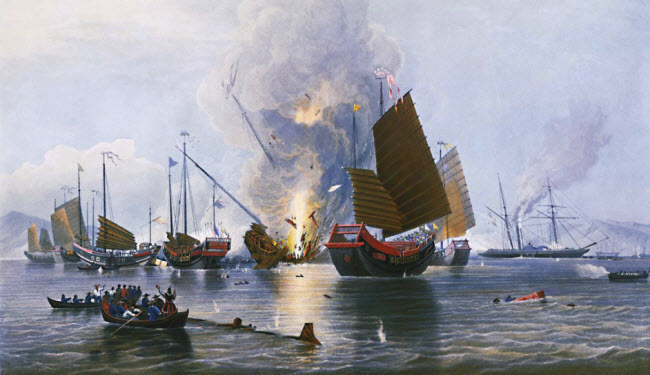The Opium Wars were two armed conflicts that took place in China in the mid-19th century between Western powers and the Qing Dynasty, which ruled the country from the mid-17th century until the early 20th century. The First Opium War began in 1839 and lasted for three years, with China on one side and the United Kingdom on the other. The Second Opium War, also known as the Arrow War or the Anglo-French War, started in 1856 and lasted for four years. It involved a coalition of Britain and France against China. In both wars, the European powers easily defeated China due to their superior military technology, forcing China to sign unequal treaties that granted Western nations commercial, legal, and territorial privileges. These treaties severely weakened the sovereignty of the Qing Dynasty, leading to its eventual collapse and the rise of the concept of the Chinese Republic in the early 20th century.

First Opium War
The First Opium War began in 1839, but before that, several disputes over trading rights had taken place. In the 18th century, China had a trade surplus with Europe, selling them porcelain, silk, and tea in exchange for silver. In response, the British East India Company expanded opium cultivation in “India” and sold it to private traders who smuggled it into “China.” By 1797, the company was sending 4,000 chests of opium annually, which was initially used as a relatively harmless medicine. However, as Chinese people began smoking it, demand grew for recreational use, leading to widespread addiction.

Due to the social and economic risks posed by the spread of opium, the Chinese emperor issued decrees making opium trade illegal in 1729, 1799, 1814, and 1831. However, these laws were largely ineffective, and imports continued to grow due to the activities of smugglers and corrupt officials. Even some Americans joined the trade, smuggling opium from “Turkey” into “China,” which increased the trade volume to an unprecedented 30,000 chests per year. Concerned about the moral degradation of his people and the outflow of silver in exchange for opium, Emperor Daoguang appointed High Commissioner Lin Zexu to end the trade. In 1839, Lin wrote an open letter to “Queen Victoria” urging her to stop the opium smuggling, but it never reached her. The emperor issued a decree confirming severe penalties for opium smuggling, and Lin ordered the confiscation of all opium in “Canton,” including that owned by foreigners. Charles Elliot, the British trade superintendent in China, tried to negotiate compensation for the confiscated opium, but he arrived too late, three days after Lin’s deadline. Chinese soldiers then imposed a blockade on British traders, and the confrontation ended with the surrender and destruction of 20,000 chests of opium.
Charles Elliot sent a letter to “London” recommending military action against the Chinese. Small skirmishes between British and Chinese ships occurred in the Kowloon River estuary on September 4, 1839. A year later, in May 1840, the British government decided to send forces to compel the Chinese to compensate British traders for their financial losses in “Canton” and to secure future trade. On June 21, 1840, a British naval force arrived off “Macau” and moved to bombard the port of “Dinghai.” The conflict saw the Royal Navy using its superior ships and guns to deliver a series of defeats to the Chinese empire. The First Opium War ended with the Treaty of “Nanjing” in 1842, the first of the unequal treaties. It forced China to cede “Hong Kong” Island and its surrounding islets to Britain, open five ports in “Shanghai,” “Canton,” “Ningbo,” “Fuzhou,” and “Amoy,” and pay a $21 million indemnity to Britain, with six million to be paid immediately and the remainder in installments. “France” secured similar privileges through treaties in 1843 and 1844.
Second Opium War

By 1853, the “Taiping” Rebellion erupted in northern China. “Ye Mingchen” was appointed the new Imperial Commissioner in “Canton,” determined to stamp out the opium trade, which was still technically illegal. In October 1856, he seized the “Arrow,” a British ship, and arrested its crew. In response, Sir John Bowring, British Governor of “Hong Kong,” called upon the East Indies Fleet and the “China” station commanded by Admiral Sir Michael Seymour, who bombarded the Pearl River forts on October 23, capturing them. When they approached “Canton,” Seymour shelled the city, but this was not enough to take control. On December 15, riots in “Canton” led to European commercial properties being set on fire. Bowring appealed to “Britain” for military intervention, and gained additional support from “France” after a French missionary was executed in inland “China” in early 1856.
The Second Opium War began, and the Allies launched military operations in late 1857, quickly capturing “Canton” and removing its defiant governor, replacing him with a more compliant official. By May 1858, the Allied forces reached “Tianjin” and forced the Chinese into negotiations. Both “Britain” and “France” sought greater concessions from “China,” including the legalization of the opium trade, expansion of cheap labor transport, opening the entire country to British traders and opium merchants, and exempting foreign imports from internal transit fees. The “Treaty of Tianjin” was signed on June 26, 1858, forcing the Chinese to pay reparations for the last war, open a second set of ten ports to European trade, legalize the opium trade, and grant foreign traders and missionaries the right to move freely within China. After a second round of fighting, including the looting of the Old Summer Palace and the occupation of the Forbidden City complex in the capital “Beijing,” these terms were confirmed by the “Convention of Peking” signed in 1860.
